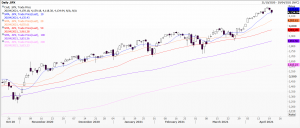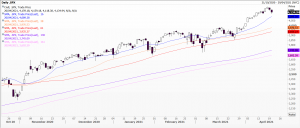Markets, motion and moving averages: Alternative options for a perennial favourite
All and sundry use moving averages, wittingly or unwittingly. A long-standing tool of choice for many technical analysts, the method, in its many guises, is used by other financial professionals, laymen and statisticians around the globe. Take UK consumer prices released today for the month of March 2021. The index rose from 109.1 to 109.4 between February and March this year. On an annualised basis, which looked at the difference in the index between April 2020 and March 2021, this came to an increase in the retail basket of 0.7 per cent. In April 2021, the annualised data series will shift forward by one month, and so on ad nauseam. It’s a moving average – of sorts.
Similarly in the farming community. Though data may not be as rigorous as that of the Office for National Statistics, farmers will have a good idea of what prices of their foodstuffs were in the last harvest, over the five before that, the peaks and troughs and more. Next year, they’ll again be casting their eye over the last five – hoping for highs and not lows.
Stock pickers and commentators regularly compare the price of one company, or an index, to its 200-day moving average; some even use 50 and 200-day moving average crossovers. These often form the basis of their recommendations. Technicians have ample time and tools to tweak their choices of moving average pairs thanks to the power of computing. Then we can fiddle around with centred, exponential, smoothed, volume adjusted and weighted moving averages.
I’ve recently seen people using a fan of moving averages, say 10-day, 20-day, 50-day and 100-days, with a break of each one in theory setting off a staggered build or offloading of a core investment position. In a way it’s sort of aligned to Ichimoku cloud charts which have a series of breaks and confirmations to help you adjust your attitude to the prevailing trend.
What I’ve recently considered trying out is using Fibonacci number-based time frames for simple moving averages. Glyn Bradney MSTA tipped me off years ago about using 1.6 as well as 1 and 2 standard deviations around the mean regression. Believe it or not this came to mind when I was looking into the current 6 variants of the Covid-19 virus. The UK/Kent one (Nelly N501Y family) is B.1.1.7; the South African one (of the same family) is B.1.351. Brazil’s version of Nelly is P.1 – like Pi π, and India’s is B.1.617. Yes, I know, lockdown is getting to me but look at the second chart where I’ve used 16-day, 38-day, 61-day, 138-day and 161-day moving averages. Just for fun!
Tags: crossover, moving averages, time intervals, weighting
The views and opinions expressed on the STA’s blog do not necessarily represent those of the Society of Technical Analysts (the “STA”), or of any officer, director or member of the STA. The STA makes no representations as to the accuracy, completeness, or reliability of any information on the blog or found by following any link on blog, and none of the STA, STA Administrative Services or any current or past executive board members are liable for any errors, omissions, or delays in this information or any losses, injuries, or damages arising from its display or use. None of the information on the STA’s blog constitutes investment advice.
Latest Posts
- Trust Me, I’m a Technical Analyst by Trevor Neil: Why Charting Is as Important Now as Ever October 15, 2025
- Why Networking Still Matters: Reflections from the STA Drinks at the National Liberal Club October 2, 2025
- Fireside Wisdom: Clive Lambert in Conversation with Tony LaPorta September 10, 2025
- Understanding Triple RSI Divergence: A Potential Warning Sign for the S&P 500 September 1, 2025
- Unlock Your Potential in Finance: Join the Society of Technical Analysts – No Qualifications Required July 24, 2025






















Latest Comments